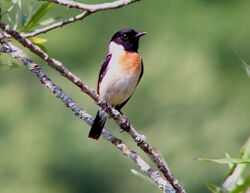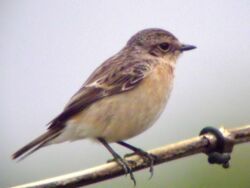Biology:Amur stonechat
| Amur stonechat | |
|---|---|

| |
| Male, eastern Hokkaido, Japan | |
| Scientific classification | |
| Domain: | Eukaryota |
| Kingdom: | Animalia |
| Phylum: | Chordata |
| Class: | Aves |
| Order: | Passeriformes |
| Family: | Muscicapidae |
| Genus: | Saxicola |
| Species: | S. stejnegeri
|
| Binomial name | |
| Saxicola stejnegeri (Parrot, 1908)
| |
| Synonyms | |
|
See text | |
The Amur stonechat or Stejneger's stonechat (Saxicola stejnegeri) is a species of stonechat native to eastern Asia. It breeds in central and eastern Siberia, Japan , Korea, northeastern China , and eastern Mongolia, and migrates south to southern China and Indochina in winter.[1]

It is a small bird 11.5–13 cm long, very closely similar to the Siberian stonechat in both plumage and behaviour, differing in only small details, notably having a slightly broader-based bill 4.7–5.7 mm wide (4.0–4.9 mm wide in Siberian stonechat) and slightly less white on the rump.[2]
Vagrants have been reported west to Great Britain,[3] east to Alaska,[1] and south to Borneo.[1]
Taxonomy
Amur stonechat was generally considered a subspecies of either common stonechat (as Saxicola torquatus stejnegeri[2]) or Siberian stonechat (as Saxicola maurus stejnegeri,[1]), but recent genetic evidence has shown that it is distinct, in a basal position in the common stonechat superspecies;[4] on which basis it is now accepted as a distinct species.[5]
The Latin binomial commemorates the Norwegian ornithologist Leonhard Hess Stejneger.
References
- ↑ 1.0 1.1 1.2 1.3 Urquhart, E., & Bowley, A. (2002): Stonechats. A Guide to the Genus Saxicola. Christopher Helm, London. ISBN:0-7136-6024-4
- ↑ 2.0 2.1 Svensson, L. (1992). Identification Guide to European Passerines. British Trust for Ornithology, Thetford. ISBN:91-630-1118-2.
- ↑ Robertson, I. S. (1977). Identification and European status of eastern Stonechats. British Birds 70: 237-245.
- ↑ Zink, R.M., Pavlova, A., Drovetski, S. V., Wink, M., & Rohwer, S. (2009). Taxonomic status and evolutionary history of the Saxicola torquata complex. Molecular Phylogeny and Evolution 52: 769-773. Abstract.
- ↑ IOC World Bird List Family Muscicapidae
External links
Wikidata ☰ Q6739527 entry
 |

